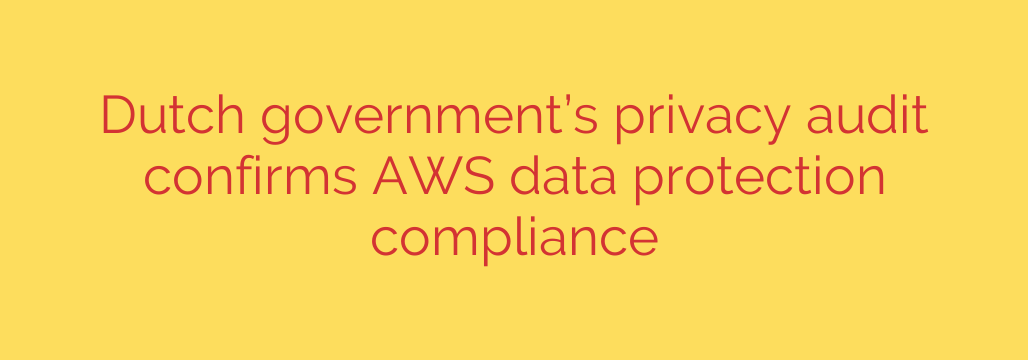
Is AWS Secure Enough for Government Data? A Landmark Audit Says Yes
In an era of strict data privacy regulations like GDPR, organizations—especially in the public sector—face immense pressure to ensure their cloud infrastructure is secure and compliant. The question of where data is stored, who can access it, and how it’s protected is a constant concern. Now, a recent, in-depth data protection audit commissioned by the Dutch government offers significant reassurance for anyone using Amazon Web Services (AWS).
The comprehensive audit, known as a Data Protection Impact Assessment (DPIA), concluded that Amazon Web Services (AWS) provides the necessary tools and safeguards for organizations to process data in full compliance with the GDPR. This finding is a major vote of confidence in the platform’s security and privacy capabilities, particularly for handling sensitive information.
Understanding the In-Depth Privacy Audit
A DPIA is a systematic process designed to identify and minimize the data protection risks of a project or plan. In this case, the Dutch Ministry of Justice and Security commissioned a thorough review of AWS services to ensure they could be used safely by government agencies.
The audit examined the technical and organizational measures AWS has in place to protect data, focusing on whether these measures align with the stringent requirements of Europe’s GDPR. The results were overwhelmingly positive, providing a clear framework for public and private organizations to leverage AWS confidently.
Key Findings from the Data Protection Audit
The report highlighted several critical areas where AWS demonstrates strong data protection practices. These findings serve as a valuable guide for any organization building on the AWS cloud.
Complete Customer Control: The audit confirmed that customers retain full control over their data, including where it is stored. By selecting a specific AWS Region (such as one within the European Union), organizations can ensure their data remains within a defined geographic boundary, helping to meet data residency requirements.
Robust Encryption Capabilities: Robust encryption is central to AWS’s security posture. The platform offers powerful tools, like AWS Key Management Service (KMS), which allow customers to control the encryption keys used to protect their data. This means that even AWS cannot access the customer’s encrypted content.
Strict Access Management: The audit validated that AWS provides the necessary mechanisms for managing who can access data and services. Using AWS Identity and Access Management (IAM), organizations can enforce the principle of least privilege, ensuring that users and applications only have the permissions they absolutely need.
No Unmitigated High Risks: Crucially, the DPIA found no high-risk issues that could not be resolved by correctly configuring AWS services. This underscores that the platform provides a secure foundation, but that organizations must take an active role in implementing security best practices.
The Shared Responsibility Model in Action
This audit serves as a perfect real-world example of the AWS Shared Responsibility Model. While AWS is responsible for the “security of the cloud”—protecting the infrastructure that runs all of the AWS services—the customer is responsible for “security in the cloud.”
This means that while AWS provides the secure data centers and compliant services, it is the customer’s responsibility to configure those services correctly. This includes managing access controls, encrypting data, and ensuring network configurations are secure. The audit confirms that the tools are there; it’s up to you to use them effectively.
Actionable Security Tips for Your AWS Environment
Based on the audit’s findings, here are actionable steps you can take to ensure your organization’s AWS environment is secure and compliant:
- Strategically Choose Your AWS Region: If data residency is a concern, host your data and services in an AWS Region located within your required jurisdiction, such as Frankfurt, Ireland, or Stockholm for EU compliance.
- Encrypt Everything: Use AWS KMS to manage your own encryption keys. Implement a policy of encrypting all data at rest (in services like S3 and RDS) and in transit.
- Implement Least Privilege: Configure IAM roles and policies meticulously. Avoid using root accounts for daily tasks and grant permissions on a need-to-know basis.
- Conduct Your Own DPIAs: While this government audit is a powerful endorsement, you should still conduct your own Data Protection Impact Assessments for your specific applications to identify and mitigate any unique risks.
What This Means for Your Organization
This landmark government audit provides more than just reassurance; it offers a blueprint. For any organization concerned about GDPR compliance, data sovereignty, and cloud security, this report validates that AWS can be a secure and compliant partner.
The findings demonstrate that with proper configuration and adherence to best practices, the AWS platform provides a powerful foundation for building secure applications. It shifts the conversation from “Is the cloud secure?” to “How are we securing our workloads in the cloud?”
Ultimately, the audit is a clear signal that a proactive approach to security is the key to success. The tools for building a world-class, compliant, and highly secure infrastructure are available—it’s up to every organization to implement them.
Source: https://aws.amazon.com/blogs/security/dutch-government-successfully-completes-privacy-audit-of-aws-data-protection-practices/








